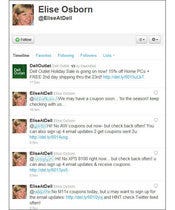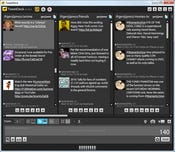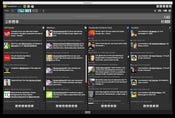Twitter: The Business Case For And AgainstTwitter: The Business Case For And Against
The microblogging platform's meteoric rise makes many enterprises think they need to jump on board. However, it's not for every company; here's how to know if a Twitter presence is right for you.


Businesses Take Action With Twitter
(click image for larger view)
Slideshow: Businesses Take Action With Twitter
No one needs persuading that social media is here to stay. In only a couple of years, Twitter went from what seemed like a mere gimmick to one of the fastest ways to spread the word about something. That makes it seem like an ideal medium for a business to raise notice about its products and services, and in fact that's what a great many companies do.
The problem is that the very audience you'll be seeking to engage with Twitter is also the same audience that has a built-in skepticism about social media. Twitter users by and large are entirely too conscious of how any segment of the Internet, or any communications medium at all, can be turned into a mere advertising vehicle -- and thus made that much easier to ignore. To that end, there are cases to be made both for and against Twitter when using it to spread information about what you do.
The Real Uses For An Official Twitter Stream
From the outside, Twitter may seem like a one-way medium -- a bullhorn from which you can broadcast things you want people to hear. That's the most common corporate use of Twitter so far, as a kind of news ticker or early-announcement system. There's no reason not to use Twitter for this, and if nothing else it provides a quick and easy way for people to syndicate announcements -- e.g., send them directly to followers' cell phones, etc.
But Twitter's two-way nature means eventually, people are going to want to talk back -- and they will expect at least some response. In the long run, Twitter works best as a conversational medium, not simply as a way to shout out.
Because this approach is still so new, it's often tough for a company to adopt it properly. Many companies dip their toe into Twitter's pool by creating an official Twitter account, or sometimes multiple accounts for different divisions. Sometimes they do this without a clear idea of what that opens themselves up to: they're prepared to broadcast, but not receive.
That doesn't make their Twitter feed useless, but it does make it that much less useful in the eyes of those who come to Twitter to use it to its full potential.
Six Cases For Twitter
The best corporate uses of Twitter have a few basic hallmarks. Each of these is an argument for how Twitter can be a major addition to a company's customer-facing strategy, even if they all come with caveats.

Businesses Take Action With Twitter
(click image for larger view)
Slideshow: Businesses Take Action With Twitter
1. A specific person's voice can speak for the company. Rather than just serving as a generic mouthpiece for the company, a Twitter account is maintained by someone visible within the company. This is not merely a PR frontman, but someone intimately qualified to speak for the company and who has some perspective on it from the inside.
Aneta Hall, emerging media manager for Pitney Bowes, has said, "Twitter is for individuals rather than brands." That may simply be another way of saying that a brand is made up of individuals, and the more they're empowered to speak on behalf of the company, the better.
Having a specific person's voice can humanize things in both directions, too. As Christopher Barger of GM has pointed out, it's more difficult to say nasty things about an individual as opposed to a company. Criticism directed at a specific person tends to be that much more civil.
Sometimes a specific Twitter account represents a specific person, or a facet of a brand. The Dell Outlet Twitter account, for instance, deals exclusively with Dell Outlet announcements and news; Elise Osborn handles the questions/comments side of things for the Dell Outlet brand.
JetBlue has a single Twitter account -- @JetBlue -- but the account is not aggressively promoted to regular JetBlue customers. "We want to grow naturally with the Twitter audience," said Morgan Johnston, manager of corporate communications with JetBlue, in an exchange of tweets with the folks at Mashable.com.
2. The company wants to create conversations between individuals about their brand. Once you give people the power to speak on behalf of a given brand, conversations start -- not just talk that directly supports the brand, but talk that shows how the people behind that brand are lively and engaged folks.
My personal favorite example of this involves Vertical, a small independent publisher with a Twitter stream maintained by its marketing director, Ed Chavez. Every few months he polls his followers (mostly avid readers) for possible titles that they could license and translate from Japanese, which generates a good deal of discussion from their followers about what titles would be worth looking into. The result is a conversation that consistently draws in fresh followers and gets them talking about Vertical as a brand. And because the company is small and tightly-knit, with few layers between Chavez and his higher-ups, he has that much more leeway to speak freely.

Top 5 Twitter Clients Revealed
(click image for larger view)
Slideshow: Top 5 Twitter Clients Revealed
3. The company is prepared to listen and talk. Another thing Johnston of JetBlue has said is "Twitter is a great way to talk to many, but even better for listening." Like Google's Zeitgeist tool before it, any major brand can search Twitter with some relevant keywords to get a general impression of what people are saying about them.
This is above and beyond just reading what messages are sent directly your way, which are easy enough to track; this also covers what people are saying about you generally -- good, bad, or indifferent. If someone makes a random mention of how your brand is used in a novel way through Twitter, that gives you something you can point to.
4. The company is patient. Most buzz built through Twitter is achieved by reaching a few people who, by dint of being followed by others, can casually influence many others. This takes time, but the rewards reaped this way are lasting: better to reach a few well than a great many poorly.
5. The company understands how Twitter can work against them if they don't have it working for them. Most of us are passingly familiar with the kinds of public-relations disasters that Twitter can exacerbate. The very thing that makes Twitter so powerful -- the ability to speak directly to individuals, a small crowd that can in turn influence bigger crowds -- is also what makes it unruly. All the more reason to make it work for you whenever possible.
6. The company understands how Promoted Tweets are a two-edged sword. Among the things Twitter offers specifically for business is Promoted Tweets. They're clearly marked as such, in much the same way ads in magazines that resemble the rest of the publication are labeled "SPECIAL ADVERTISING SECTION," or something similar. But the mere association of a Promoted Tweet with a given brand can be problematic, since that dilutes the feeling of a real-life person being behind the communications.
One way to avoid this is, again, to not mix promoted and conversational accounts: keep a general "mouthpiece" account for promotion, and let the accounts with an identifiable human being behind them speak for themselves.

Top 20 Apps For Managing Social Media
(click image for larger view)
Top 20 Apps For Managing Social Media
Six Reasons Not To Jump Into Twitter
There are still plenty of reasons why there may not be a case for using Twitter in your business. Any one of them by themselves may not be an obstacle, but if several of them present themselves at once, that's a sign that adopting Twitter may be premature.
1. Twitter cannot be used as a one-for-one substitute for other forms of communication. It's not a wise idea, for instance, to ditch your entire help desk or customer-facing support system and replace it with Twitter. If you only have manpower for one and not the other, then it doesn't make sense to swap out something old and proven for something new and relatively untested. It also doesn't make sense to abandon email for Twitter, or something equally drastic.
2. Twitter requires dedicated manpower. Depending on the size of your company, if you don't have a dedicated social-media team (or even just a single person who focuses on that), using Twitter in a two-way fashion can be a time-sink. Conversations tend to mushroom, spiral outwards, and include people you might never have expected to join in.
Unless you're merely using Twitter as a broadcast-only medium, you'll want to devote someone to the job of having those conversations. Also, if you're going to set someone up as your social-media person, he needs to be someone who can be trusted to speak freely. If this isn't possible -- whether because you haven't found the right person, or because of policy -- then that's another strike against Twitter.
3. Filtering and management tools for Twitter are still maturing. This is another argument for having someone in your organization dedicated to managing social media. Twitter by itself has some tools for screening the signal from the noise, but they're mainly designed for individuals. Third-party programs like TweetDeck or services like Slipstre.am help that much more, but are still largely dependent on primitive mechanisms like keywords instead of intelligent heuristics. The best filter is still a human being, and that goes for Twitter as much as any other communications medium. (This goes not only for Twitter traffic directed at you, but wading through the rest of Twitter for useful traffic that's about you generally.)
What's trickier to deal with than spam are disgruntled and combative people -- folks who may well have a genuine grievance and whom you ignore at your own peril lest they turn around and vilify you. That requires, as above, full-time work to manage effectively.

Businesses Take Action With Twitter
(click image for larger view)
Slideshow: Businesses Take Action With Twitter
4. The kind of audience reached through Twitter may not be a fit. Twitter's audience of early adopters has widened a bit, but it's still attracting a very specific kind of user. Most Twitter users are between the ages of 26 and 44, college graduates or still in school, and earn between $25K and $75K a year. This means services aimed at retirees, for instance, or big-ticket buyers, may fall flat. Or, they may only reach a too-marginal segment of your prospective audience, people who don't have much of an audience of their own and don't serve to spread word effectively about your brand.
5. Who knows where Twitter will be in five years? Technologies appear, evolve, and either die or are subsumed into other things. Nobody wants to make a losing bet by depending on a technology or service that's just going to be phased out. Twitter seems particularly vulnerable to being thought of this way, at least in part because of its remarkable success in such a short time. Anything that becomes that popular so soon is likely to burn itself out, isn't it? And if so, why invest in something that volatile?
The short answer is that the investment may not need to be deep to reap decent rewards. Now that the initial burst of enthusiasm has settled down, people are discovering Twitter's real utility: as a way to both quickly broadcast a message and create instant two-way conversations in a public fashion. It's not a replacement for anything that already exists, but a complement, so in that sense it isn't as problematic if in five years Twitter is old news. Use of it can be wound down that much more gracefully, and the depth of commitment needed to make it useful mostly involves specific human faces rather than great amounts of infrastructure or programming.
Also, if in the future some other medium comes along that replaces or augments Twitter, the lessons learned from having used it won't be lost. They can be rolled straight into the new medium, in much the same way lessons learned from having a presence on services like AOL and CompuServe were rolled forward into the Web.
Overall, A Strong Case Exists
A strong case exists for making Twitter a part of a company's social media strategy. That, however, implies that said company has, or requires, or can implement, a social media strategy in the first place -- and that it can do so in a way that uses Twitter to its fullest potential.
Social media is about conversations, and any company not prepared to have a conversation with its customers, with all that implies, won't see Twitter as a tool. But creating conversations with customers is becoming more crucial than ever -- and if it isn't done with Twitter, it'll have to be done somehow.
SEE ALSO:
Top 5 Twitter Clients Reviewed
Firms Integrating Social Media With CRM
Five Ways To Fool A Twitter Sentiment Tool
Social Media Users Expect Rapid Response To Complaints
Few Businesses Use Social Media For Disaster Recovery
About the Author
You May Also Like








